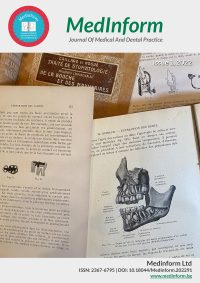Issue One 2022
2022, Vol. 9, issue 1, (June)
Original Article
Assessment of the association of bruxism with caffeine consumption and nicotine intake
Abstract:
Introduction: Caffeine and nicotine are two legal stimulants among the world’s most widely used psychoactive substances. The relationship between these popular daily stimulants and bruxism is insufficiently investigated. The evidence on the association between these factors and bruxism is controversial. Aim: Our study aimed to investigate the possible association between using the most marketable daily stimulants – nicotine and caffeine, and self-reported bruxism. Material and methods: The study included 137 (n=137) participants aged from 30 to 61 years (Mean 47.08±0.59; SD=6.92) – 44.53% (n=61) of participants were male, and 55.47% (n=76) were female. Questionnaires evaluated the relationship between cigarette smoking, caffeine consumption and bruxism. Results: Bruxism was associated highly with tobacco use. Smoking appears is more prevalent among bruxers (71.43%). The cigarette smoking was significantly associated with the bruxism (rho (137)=0.327, p <0.001). Consumption of coffee and caffeine containing beverages was not related to the bruxism (rho(137)=-0.096, p ˃0.05). Chi-square test for independence indicated no significant association between bruxism, caffeine consumption (χ2 (2, n=137)=2.391, p=0.303, phi = 0.132.) and nicotine intake (χ2 (1, n=137)=4.967, p=0.083, ph =0.190.) in terms of gender. Conclusions: Based on limited evidence in this study, bruxism was associated positively with nicotine intake. The association between the studied stimulants could not be neglected. However, there is still a necessity for additional evidence. This association should be further assessed in the presence of confounding factors.
Keywords: bruxism, caffeine, nicotine, psychoactive substances, stimulants
Authors:
Dimitar Kirov; 1. Department of Prosthetic Dental Medicine, Faculty of Dental Medicine, Medical University, Sofia, Bulgaria;Lilia Doichinova; 2. Department of Pediatric Dental Medicine, Faculty of Dental Medicine, Medical University, Sofia, Bulgaria;

